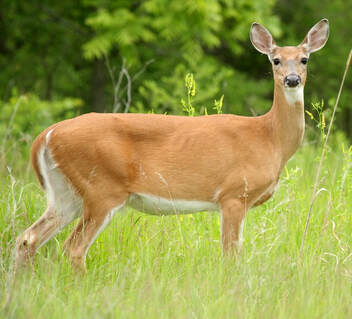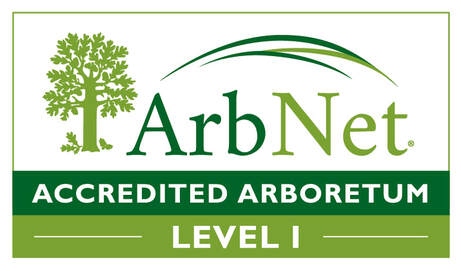White-Tailed Deer (Odocoileus virginianus)

Common Name: White-tailed Deer
Scientific Name: Odocoileus virginianus
Physical Description: As adults, White-tailed Deer have coats that change from grey in the winter months to a reddish brown in warmer months. The seasonal color change helps with camouflage. They have darker dorsal (upper side or back) and lighter ventral (underside or abdomen) coloration, giving them countershading camouflage. They have white patches of fur on their lower legs and faces. The young have reddish-brown coats with white spots that help as camouflage. Adult females are called does and the young are called fawns. Adult males are called bucks and they grow antlers every year in April or May that have a layer of velvet on them. In August or September the antlers shed their velvet and are used in sparring matches with other males for mating rights. The antlers fall off in winter. Every year that the antlers grow back they are larger and have more points. If a buck reaches an advanced age the antlers may grow back smaller and thinner. White-tailed Deer weigh between 125 and 300 pounds. They are 5-7 feet long and 2-4 feet tall at the shoulder.
They have good eyesight and acute hearing. However, it is their sense of smell that they depend upon the most to alert them to danger. They are shy, nervous and easily startled. They use speed and agility to outrun predators. They can sprint up to 30 mph. They can leap as high as 10 feet off the ground and as far as 30 feet in one leap. They are also excellent swimmers and use streams or lakes to escape predators. White-tailed Deer are primarily nocturnal or crepuscular which means they are most active at night and browse for food mainly at dawn and dusk. They will occasionally venture out during daylight hours.
They communicate with each other via scents and vocally via grunts, wheezes, and bleats. Disturbed deer often whistle or snort to vocalize their annoyance.
Habitat: During warm weather, they inhabit fields and meadows near forests that they can use for shade. In colder weather, they keep to the coniferous forests for shelter from the harsher weather.
Range: They can be found from southern Canada in North America through northern South America.
Diet: They eat a variety of plant food including leaves, twigs, grass, corn, acorns and even lichen and other fungi. Their diet varies by season since they eat what is available. Adults eat between 5 to 7 pounds of food each day depending on the season.
Lifespan: They live 3 years on average in the wild, but up to 10 years. In human care they live an average of 16 years, but up to 23 years.
Social Structure: A female usually gives birth to one fawn in her first pregnancy but in later years may have two or three each time. Fawns can walk as soon as they are born. They nurse until they are weaned at 10 weeks of age. Females are very protective of their fawns. They leave them in hiding places while they forage for food. The fawn will lay flat on the ground with their necks stretched out for as long as four hours.
Fawns start to follow their mothers to forage at one month. Young males stay with their mother for one year and females stay for two years. Families live together in herds.
Status: Least Concern1
Other: This Connecticut native can be found throughout the state, from urban to rural areas.
1 https://www.iucnredlist.org/species/42394/22162580
Scientific Name: Odocoileus virginianus
Physical Description: As adults, White-tailed Deer have coats that change from grey in the winter months to a reddish brown in warmer months. The seasonal color change helps with camouflage. They have darker dorsal (upper side or back) and lighter ventral (underside or abdomen) coloration, giving them countershading camouflage. They have white patches of fur on their lower legs and faces. The young have reddish-brown coats with white spots that help as camouflage. Adult females are called does and the young are called fawns. Adult males are called bucks and they grow antlers every year in April or May that have a layer of velvet on them. In August or September the antlers shed their velvet and are used in sparring matches with other males for mating rights. The antlers fall off in winter. Every year that the antlers grow back they are larger and have more points. If a buck reaches an advanced age the antlers may grow back smaller and thinner. White-tailed Deer weigh between 125 and 300 pounds. They are 5-7 feet long and 2-4 feet tall at the shoulder.
They have good eyesight and acute hearing. However, it is their sense of smell that they depend upon the most to alert them to danger. They are shy, nervous and easily startled. They use speed and agility to outrun predators. They can sprint up to 30 mph. They can leap as high as 10 feet off the ground and as far as 30 feet in one leap. They are also excellent swimmers and use streams or lakes to escape predators. White-tailed Deer are primarily nocturnal or crepuscular which means they are most active at night and browse for food mainly at dawn and dusk. They will occasionally venture out during daylight hours.
They communicate with each other via scents and vocally via grunts, wheezes, and bleats. Disturbed deer often whistle or snort to vocalize their annoyance.
Habitat: During warm weather, they inhabit fields and meadows near forests that they can use for shade. In colder weather, they keep to the coniferous forests for shelter from the harsher weather.
Range: They can be found from southern Canada in North America through northern South America.
Diet: They eat a variety of plant food including leaves, twigs, grass, corn, acorns and even lichen and other fungi. Their diet varies by season since they eat what is available. Adults eat between 5 to 7 pounds of food each day depending on the season.
Lifespan: They live 3 years on average in the wild, but up to 10 years. In human care they live an average of 16 years, but up to 23 years.
Social Structure: A female usually gives birth to one fawn in her first pregnancy but in later years may have two or three each time. Fawns can walk as soon as they are born. They nurse until they are weaned at 10 weeks of age. Females are very protective of their fawns. They leave them in hiding places while they forage for food. The fawn will lay flat on the ground with their necks stretched out for as long as four hours.
Fawns start to follow their mothers to forage at one month. Young males stay with their mother for one year and females stay for two years. Families live together in herds.
Status: Least Concern1
Other: This Connecticut native can be found throughout the state, from urban to rural areas.
1 https://www.iucnredlist.org/species/42394/22162580






